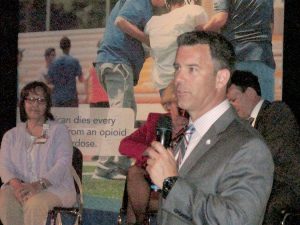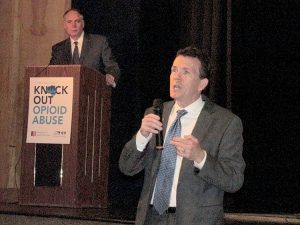By John Burton |
MIDDLETOWN — “We know how important addressing this epidemic is,” said Mary Ann Christopher, senior executive for clinical affairs for Horizon Blue Cross Blue Shield of New Jersey, referring to the opioid/heroin abuse plaguing all communities in Monmouth County and the state.
Christopher was one of a series of speakers at Middletown High School South on May 23 who detailed how the misuse of prescription painkillers can lead to heroin addiction and how it is impacting the community. She also spoke of the now frightening increase in the abuse of fentanyl, a synthetic opioid that is 50 to 100 times more potent than morphine.
Speaking to an auditorium filled with parents, high school students, educators and interested members of the public, the panel of health care, law enforcement and medical and addiction professionals offered their take on what they labeled as a “scourge” that no community is immune to.
“People think we are from Middletown, New Jersey. I’m from Colts Neck. It doesn’t happen here,” said Victor Almeida, D.O., a physician who works in the emergency department of Monmouth Medical Center, Long Branch. “It does,” he said.
“This has been our No. 1 priority,” Monmouth County Prosecutor Christopher J. Gramiccioni told the audience. He and representatives of his office regularly attend school gatherings like this because opioid abuse is the “No. 1 killer in Monmouth County,” Gramiccioni said.
The Partnership for a Drug-Free New Jersey has been conducting what it calls town hall meetings, dubbed “Knock Out Opioid Abuse,” at venues to discuss the national and statewide epidemic and its impact on local communities and to inform the public about available programs to address it.
Over an approximately two-hour period, panel members took the opportunity to express their perspectives and to allow the audience to ask questions and offer their own take on the problem.

Gramiccioni provided the “shock” quota for the evening, offering disturbing statistics about the extent of heroin and opioid abuse for the county’s 53 municipalities. So far for the five months of 2017, Monmouth County has had 41 heroin/opioid-related deaths, with overall drug-related deaths currently at 49. So far this year the county has had two homicides. By comparison, in 2016 there were 148 heroin/opioid fatalities with a total of 164 drug-related deaths, and six homicides.
Fatalities caused by opioids and heroin are the fourth leading cause of death for young people in the U.S., while it leads the way in Monmouth County, according to Gramiccioni. “That is just scary,” he said.
Heroin, he said, “is the most addictive substance on the face of the earth and you can buy right here,” in your community, where the strength and purity heightens its addictive quality and danger.
“It’s chic now,” Gramiccioni said. “It’s so pure you don’t need to shoot it. You can snort it.”
The problem started more than 30 years ago with an article in the “New England Journal of Medicine,” Almeida said. That article argued that new pain-management medicines like oxycodone and Percocet were essentially safe and nonaddictive and doctors in training were told to treat pain aggressively. Those who didn’t were thought to be neglecting their patients’ care, he said.
What we now know, Almeida said, is that people can become addicted to opioid painkillers in as little as five days and those who become addicted are 40 times more likely to become addicted to heroin. In comparison, those who use marijuana are three times as likely to use heroin; cocaine users are 15 times more likely to use heroin; and those addicted to alcohol are twice as likely to use heroin, Almeida said.

“I wanted to believe I was making a difference,” said Angelini, who serves as chief executive officer of Preferred Behavioral Health Group, a nonprofit behavioral health care organization.
“If you had told me we would have been speaking about heroin as we’re talking about heroin now,” when she started working in recovery and treatment 20 years ago, said Angelini, “I would have left the field, frankly.”
Echoing others on the panel, Angelini told of the downward spiral that can begin with the well-intentioned actions of the personal physician. “It’s that slow beating of the drum,” she said. “That if a doctor prescribes it, it has to be good for us.”
And with heroin relatively cheap and potent, it becomes more of an attraction to addicts who may not be able to obtain pain pills.
“It’s so important to consistently talk to your children,” about these dangers, she said, stressing parents have to be parents and sometimes be stern and not worry about being the child’s friend. “We lost that piece of parenting,” she said.
Angelini and others on the panel also used the opportunity to make the message clear that stigmatizing addicts will only have negative consequences.

State Assemblyman Declan O’Scanlon (R-13), told of witnessing the “horrific battle of a loved one with an addiction.” O’Scanlon lost his mother to alcohol abuse as she battled the disease for 10 years; and just this past winter, he lost his brother from the same disease. He watched and tried to help his family members who committed “slow-motion suicide,” he said.
He has since turned his own experiences into legislation, with bills that he believes will make treatment more accessible and curtail doctors’ ability to offer long-term and high-dosage prescriptions.
However, there is reason to be hopeful, panel members said. “There is help out there,” in treating the disease and in addressing the stigma, said Ninette Tuerk, a licensed certified alcohol and drug counselor.
But there is a major key to the process, Tuerek said. “You have to start talking about it.”
This article was first published in the June 1-June 8, 2017 print edition of The Two River Times.














